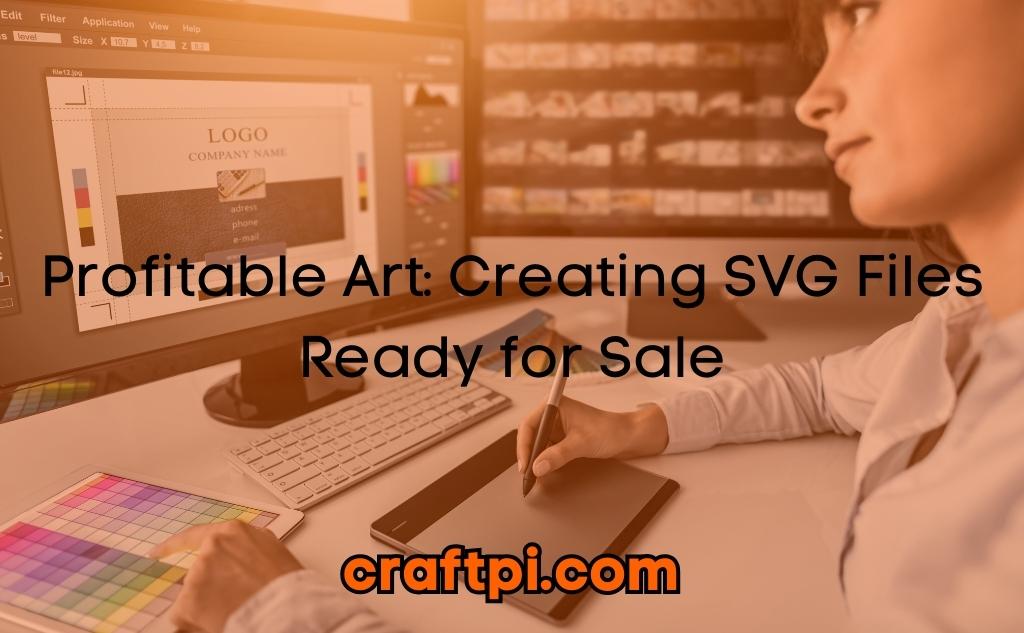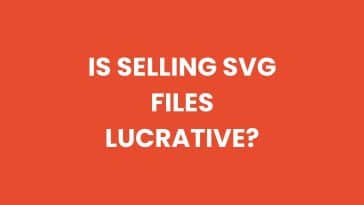Are you looking to tap into the lucrative market of SVG (Scalable Vector Graphics) files? Whether you’re a seasoned graphic designer or a budding artist, creating and selling SVG files can be a profitable venture. In this comprehensive guide, we’ll walk you through the essential steps of understanding the demand for SVG files, researching popular themes and trends, choosing the right software for creating SVG files, mastering the art of vector design, optimizing SVG files for different platforms, implementing pricing strategies, and effectively marketing and promoting your SVG creations. Let’s dive into the world of SVG files and unleash your creative potential!

Understanding The Demand For Svg Files
Understanding the demand for SVG files is essential for those looking to create and sell digital designs. SVG, which stands for Scalable Vector Graphics, is a popular file format used for creating high-quality graphics that can be scaled to any size without losing clarity. In recent years, SVG files have gained significant popularity due to their versatility and compatibility with various platforms, including websites, mobile apps, and graphic design software.
One of the primary reasons why SVG files are in high demand is their ability to be resized without pixelation or loss of quality. This scalability makes SVG files ideal for a wide range of applications, including logos, icons, illustrations, and animations.
Moreover, SVG files are widely supported across different web browsers, making them an excellent choice for web designers and developers. They can be embedded directly into HTML code, allowing for easy integration and customization. Additionally, SVG files are compatible with various graphic design software, allowing designers to create and manipulate their artwork using the tools they prefer. By understanding the demand for SVG files, you can tailor your creations to meet the needs of your target audience, whether it’s graphic designers, web developers, or hobbyists.
Researching popular themes and trends within these communities can provide valuable insights into the types of SVG files that are currently in high demand.
| Popular Themes | Trends |
|---|---|
| Floral designs | Geometric patterns |
| Typography and quotes | Abstract shapes |
| Animals and wildlife | Minimalist designs |
Researching Popular Themes And Trends
Researching popular themes and trends is an essential step in creating and selling SVG files. By understanding what themes and trends are in demand, you can better cater to the needs and preferences of your target market. So, how can you conduct effective research to stay up to date with the latest popular themes and trends?
Firstly, it is important to utilize various online platforms and resources. Social media platforms like Instagram, Pinterest, and Facebook can provide valuable insights into the popular themes and trends that are currently resonating with people. By following relevant accounts, joining groups, and analyzing popular posts and hashtags, you can identify patterns and themes that are in high demand.
Additionally, you can explore online marketplaces and websites that cater to SVG files. These platforms often have sections or categories dedicated to trending or popular themes. By exploring these sections, you can gain inspiration and ideas for your own creations. This can help you create SVG files that are not only of high quality but also in line with the current market demands. Furthermore, don’t overlook the power of keyword research. By using tools like Google Trends, you can identify the popularity of various themes and topics over time. This data can help you see which themes and trends are consistently in demand and which ones are declining. Incorporating popular keywords and phrases in your SVG file titles and descriptions can also improve your visibility and attract more potential buyers.
| Advantages of Researching Popular Themes and Trends |
|---|
| 1. Increased market competitiveness: By staying up to date with the latest popular themes and trends, you can ensure that your SVG files stand out from the competition. |
| 2. Improved customer satisfaction: By creating SVG files that align with the current demands of your target market, you can meet their expectations and provide them with content they truly want. |
| 3. Better sales and revenue: By offering SVG files that are in high demand, you increase the likelihood of attracting more customers and generating higher sales. |
In conclusion, researching popular themes and trends is a crucial part of creating and selling SVG files successfully. Utilizing online platforms, engaging in keyword research, and exploring dedicated marketplaces can help you identify the themes and trends that are currently in demand. By staying up to date and incorporating these popular themes into your SVG files, you can increase your market competitiveness, enhance customer satisfaction, and ultimately drive better sales and revenue.
Choosing The Right Software For Creating Svg Files
When it comes to creating SVG files for selling, one of the most crucial decisions is choosing the right software. The software you select will have a significant impact on the quality and functionality of your SVG files. It’s essential to understand the features and capabilities of different software options before making a decision.
Adobe Illustrator: Adobe Illustrator is a popular choice among professional graphic designers. It offers a wide range of tools and features to create intricate and sophisticated SVG files. With its vector-based capabilities, Illustrator allows for precise control over shapes, lines, and colors. It also provides advanced features like layers, brushes, and effects, enabling you to create visually stunning SVG files.
Inkscape: Inkscape is a free and open-source software known for its powerful vector editing capabilities. It provides a comprehensive set of tools for creating SVG files, including drawing tools, shape manipulation, text editing, and path operations. Inkscape also supports advanced features like gradients, transparency, and filters. Although it may not have all the advanced features of Illustrator, Inkscape is a great choice for beginners or those on a budget.
| Software | Pros | Cons |
|---|---|---|
| Adobe Illustrator | Wide range of toolsPrecise control over shapes and colors | ExpensiveSteep learning curve for beginners |
| Inkscape | Free and open-sourcePowerful vector editing capabilities | Lacks some advanced featuresMay have performance issues with complex designs |
CorelDRAW: CorelDRAW is a popular software choice for both graphic design and illustration. It provides a range of features suitable for creating SVG files, such as vector editing tools, color management, and text manipulation. CorelDRAW also offers a user-friendly interface and extensive documentation, making it easy for beginners to get started. However, it is a paid software and may not be as widely used or supported as Illustrator.
Ultimately, the right software for creating SVG files will depend on your specific needs and preferences. If you’re just starting, Inkscape could be a good option to explore. For professional designers, Adobe Illustrator offers the most comprehensive features and capabilities. Consider trying out different software and experimenting with their features to find the one that best suits your workflow and desired outcomes.
Mastering The Art Of Vector Design
In the digital age, vector design has become an integral part of various industries, from graphic design to animation. Mastering the art of vector design allows individuals to create stunning and scalable artwork that can be used across different platforms and mediums. Whether you are a professional designer or a hobbyist, honing your skills in vector design opens up a world of possibilities for creating visually appealing and versatile artwork.
One of the key aspects of mastering vector design is understanding the tools and software available for creating vector graphics. Adobe Illustrator, for example, is a widely used software that provides a comprehensive set of tools for vector design. With its intuitive interface and powerful features, Illustrator allows designers to create intricate and detailed artwork with ease. Other software options, such as CorelDRAW and Inkscape, also offer similar capabilities and can be equally effective for vector design.
Once you are familiar with the software, the next step in mastering vector design is learning the fundamental principles of vector graphics. Unlike raster graphics, which are made up of pixels, vector graphics are created using mathematical equations, which allows them to be infinitely scalable without losing quality. Understanding concepts such as anchor points, Bézier curves, and paths is essential for creating precise and clean vector artwork. When working on vector design projects, it is important to consider the target platform or medium on which the artwork will be used. Whether it is for print, web, or mobile applications, each platform has its own set of requirements and limitations. Optimizing your vector files for different platforms ensures that your artwork looks its best and maintains its quality across all devices and mediums. In addition to technical skills, having a keen eye for design and aesthetics is crucial for mastering vector design. Learning about color theory, composition, and typography can greatly enhance your ability to create visually appealing and impactful designs. By combining technical expertise with artistic sensibility, you can create vector artwork that not only looks great but also effectively communicates the intended message or concept.
| Demand for SVG Files | Popular Themes and Trends | Selling SVG Files |
|---|---|---|
| Understanding the demand for SVG files is essential for any vector designer. SVG (Scalable Vector Graphics) files have gained significant popularity due to their ability to be scaled without loss of quality. They are commonly used in web design, digital illustrations, and even crafting projects. By catering to the demand for SVG files, designers can tap into a growing market and reach a wider audience. | Researching popular themes and trends is a crucial part of vector design. Staying up-to-date with current design trends and understanding what themes resonate with your target audience allows you to create artwork that is relevant and appealing. Whether it is minimalist designs, retro aesthetics, or nature-inspired illustrations, being aware of popular themes helps you stay competitive in the ever-evolving world of design. | Pricing strategies play a significant role in the success of selling SVG files. Determining the right price for your artwork involves considering factors such as the complexity of the design, the time and effort invested, and the target market. Whether you offer individual files or bundle them in collections, finding the right pricing strategy can maximize your profits while ensuring your designs are accessible to potential customers. |
Mastering the art of vector design is an ongoing process that requires continuous learning and practice. By keeping up with industry trends, experimenting with different styles, and refining your technical skills, you can elevate your vector design abilities to new heights. Whether you are creating artwork for personal projects or looking to establish a career in graphic design, mastering vector design opens up a world of creative possibilities.

Optimizing Svg Files For Different Platforms
In today’s digital age, optimizing SVG (Scalable Vector Graphics) files for different platforms is essential for designers and creators who wish to sell their artwork. SVG files are widely used for web graphics, user interfaces, and icons due to their scalability and resolution independence. However, ensuring that these files are compatible with various platforms can be a challenging task.
Understanding the demand for SVG files
Before diving into the optimization process, it is crucial to understand why SVG files are in such high demand. With the growing popularity of websites and digital applications, the need for visually appealing and responsive graphics has skyrocketed. SVG files offer a solution by allowing designers to create graphics that scale to any size without sacrificing quality.
Choosing the right software for creating SVG files
Creating SVG files requires the use of specialized software that supports vector graphics. Adobe Illustrator and Inkscape are two popular choices among designers. These software tools offer a wide range of features and functionalities for creating and editing SVG files. It is crucial to choose the software that aligns with your design needs and expertise.
Mastering the art of vector design
While software can assist in creating SVG files, mastering vector design principles is essential for optimizing these files. Understanding concepts like anchor points, Bézier curves, and path manipulation can significantly enhance the quality and precision of your SVG artwork. Practice and experimentation are key to mastering these skills.
Optimizing SVG files for different platforms
When optimizing SVG files for different platforms, consider the limitations and requirements of each platform. Some platforms may have restrictions on certain SVG features or file sizes. It is essential to test your SVG files on various platforms and devices to ensure compatibility and optimal performance.
Pricing strategies for selling SVG files
Once your SVG files are optimized and ready for sale, determining the right pricing strategy is crucial. Research the market and evaluate the value of your artwork based on factors such as complexity, uniqueness, and demand. Consider offering different pricing tiers to cater to different customer segments and budgets.
Marketing and promoting your SVG creations
No matter how optimized your SVG files are, effective marketing and promotion are necessary to reach a wider audience. Utilize social media platforms, artist communities, and online marketplaces to showcase your SVG creations. Engage with potential customers, collaborate with influencers, and leverage search engine optimization techniques to ensure maximum visibility and exposure.
Conclusion
In conclusion, optimizing SVG files for different platforms plays a vital role in the success of selling your artwork. By understanding the demand for SVG files, choosing the right software, mastering vector design principles, and considering pricing, marketing, and promotion strategies, you can enhance the attractiveness and accessibility of your SVG creations. Remember to always stay updated with the latest industry trends and technological advancements to stay ahead in the competitive market of SVG design.
Pricing Strategies For Selling Svg Files
When it comes to selling SVG files, one of the most important aspects to consider is the pricing strategy. Setting the right price not only ensures that you are compensated fairly for your work, but it also plays a crucial role in attracting customers and maximizing your profits. In this blog post, we will explore various pricing strategies that you can implement to effectively sell your SVG files.
1. Competitive Pricing:
One popular approach is competitive pricing, where you analyze the prices set by your competitors and offer a similar or slightly lower price for your SVG files. This strategy can be effective for attracting price-sensitive customers who actively compare prices before making a purchase. However, it is important to ensure that the quality of your SVG files justifies the price you set, as customers are more likely to opt for cheaper alternatives if they perceive a lack in value.
2. Tiered Pricing:
Another pricing strategy to consider is tiered pricing. With this approach, you offer different pricing tiers based on the features or value offered in each tier. For example, you could have a basic tier with a lower price that includes a limited number of SVG files, and then have higher-priced tiers that offer additional files or exclusive designs. This strategy allows you to cater to customers with different budgets and needs, increasing the chances of making a sale.
3. Bundling:
Bundling is a pricing strategy that involves offering multiple SVG files together as a package at a discounted price. This strategy can be appealing to customers as they perceive a higher value in getting multiple files at a reduced cost compared to purchasing them individually. Additionally, bundling allows you to upsell and cross-sell your SVG files, increasing the overall revenue per customer. However, it is important to carefully structure your bundles to ensure that the included files complement each other and provide a cohesive offering.
These are just a few of the pricing strategies you can consider when selling SVG files. Ultimately, it is important to regularly evaluate and adjust your pricing strategy based on market demand, customer feedback, and the value you provide. Remember, finding the right balance between pricing and perceived value is key to successfully selling your SVG files and building a profitable business.
| Title | Description |
|---|---|
| Understanding The Demand For Svg Files | Exploring the growing demand for SVG files in various industries and understanding their versatile applications. |
| Researching Popular Themes And Trends | Tips and techniques for researching popular themes and trends to create highly marketable SVG files. |
| Choosing The Right Software For Creating Svg Files | A comprehensive guide to selecting the best software for creating high-quality and compatible SVG files. |
| Mastering The Art Of Vector Design | Exploring the techniques and skills required to master the art of vector design for creating stunning SVG files. |
| Optimizing Svg Files For Different Platforms | A detailed look at optimizing SVG files to ensure compatibility and optimal performance across various platforms and devices. |
| Pricing Strategies For Selling Svg Files | Exploring effective pricing strategies to set the right price and maximize sales for your SVG files. |
| Marketing And Promoting Your Svg Creations | Tactics and strategies for effectively marketing and promoting your SVG creations to reach a wider audience and increase sales. |
Marketing And Promoting Your Svg Creations
In today’s digital age, the demand for unique and visually appealing graphics is on the rise. SVG files have emerged as one of the most popular choices for designers and artists. SVG (Scalable Vector Graphics) is a versatile file format that allows for high-quality graphics to be displayed on various platforms and devices. However, creating SVG files is just the first step. To truly capitalize on your creations, it is vital to have a solid marketing and promotion strategy in place. In this blog post, we will explore effective techniques and strategies for marketing and promoting your SVG creations.
One key aspect of marketing your SVG creations is to understand your target audience. Who are the people most likely to be interested in your designs? Are they individuals looking for unique graphics for personal use, or are they businesses in need of branding materials? By identifying your target audience, you can tailor your marketing efforts to reach them effectively.
Once you have identified your target audience, it is essential to reach out to them through various channels. One popular method is to leverage social media platforms. Platforms like Instagram, Pinterest, and Facebook provide an excellent opportunity to showcase your SVG creations and connect with potential customers. You can create visually appealing posts or ads that highlight your designs and encourage viewers to check out your website or online store.
An important aspect of marketing and promoting your SVG creations is to establish your online presence. This can be achieved by creating a website or an online store dedicated to showcasing your designs. Your website can serve as a portfolio that displays your best work and allows visitors to browse and purchase your SVG files. You can also provide additional resources, such as tutorials or design tips, to engage with your audience and showcase your expertise. Table:
| Marketing Techniques | Benefits |
|---|---|
| Social Media Advertising | Increased visibility and reach |
| Email Marketing | Direct communication with potential customers |
| Collaborations with Influencers | Tap into existing fanbase and reach new audiences |
In addition to social media and your website, email marketing can be a powerful tool for promoting your SVG creations. Building an email list allows you to directly communicate with your audience and keep them updated about new designs, promotions, or exclusive offers. By providing value through your emails, such as free design resources or tips, you can establish trust and loyalty among your subscribers.
Another effective strategy for marketing and promoting your SVG creations is to collaborate with influencers in your niche. Influencers are individuals who have a large following and influence on social media platforms. Partnering with influencers who align with your brand and target audience can help you tap into their fanbase and reach new audiences. This can be done through sponsored posts, giveaways, or collaborations for special projects.
Frequently Asked Questions
1. What are SVG files and why do people use them?
SVG files, or Scalable Vector Graphics, are XML-based vector image formats that are widely used for their scalability and ability to retain image quality at any size. People use SVG files because they can be easily resized without losing resolution, making them ideal for various purposes such as logos, icons, website graphics, and digital designs.
2. How can I determine popular themes and trends for SVG files?
To research popular themes and trends for SVG files, you can explore design websites, social media platforms, and online marketplaces to see what types of SVG files are in demand. Additionally, paying attention to current events, seasonal trends, and popular culture can help you identify themes that resonate with people and generate higher demand for your SVG creations.
3. What software should I use to create SVG files?
There are several software options available for creating SVG files, including Adobe Illustrator, Inkscape, and CorelDRAW. Each software has its own unique features and learning curve, so it’s important to choose one that best suits your specific needs and skill level. It’s also worth considering compatibility with other design tools and the ability to export SVG files seamlessly.
4. How can I improve my vector design skills?
To master the art of vector design, practice is key. Familiarize yourself with the software you’re using, study tutorials and online resources, analyze and learn from vector artwork you admire, and experiment with different techniques and styles. Joining design communities and seeking feedback from fellow designers can also be valuable for improving your vector design skills.
5. How can I optimize SVG files for different platforms?
To optimize SVG files for different platforms, consider factors such as file size, compatibility, and technical limitations. Minimize unnecessary elements and reduce the complexity of your SVG artwork to ensure faster loading times. It’s also important to test the compatibility of your SVG files across various browsers and devices to ensure they display correctly.
6. What pricing strategies should I consider for selling SVG files?
When pricing your SVG files, it’s important to consider factors such as the complexity of the design, market demand, your target audience, and the perceived value of your creations. You can opt for fixed prices, tiered pricing based on usage or licensing options, or even offer bundles and discounts to attract customers. Regularly evaluating and adjusting your pricing strategy based on market trends and customer feedback is essential.
7. How can I effectively market and promote my SVG creations?
To market and promote your SVG creations, first identify your target audience and tailor your promotional efforts accordingly. Utilize social media platforms, design communities, and online marketplaces to showcase your work and engage with potential customers. Collaborating with influencers or running contests and giveaways can also help increase visibility. Additionally, optimizing your website and utilizing SEO strategies can make your SVG files more discoverable and attract organic traffic.




 No products in the cart.
No products in the cart.